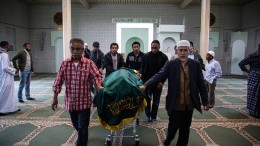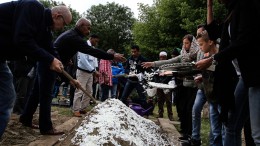Guiding One’s Soul
Photo essay – In the Bait Al-Rahmaan Mosque in the village of Ridderkerk (Netherlands) a funeral was unexpectedly held during the first Friday Prayer of Ramadan. This photo essay is about a funeral according to Moluccan Islamic tradition. In respect to Islamic customs, the deceased must be buried within 24 hours. The various customs that take place are an important aspect that should be taken into account. Besides the funeral that day, the Friday Prayer continues. The Imam reads a couple of Surahs from the Quran during the sermon.
To accompany the deceased to the final resting place, subtle customs are shown. There is a short prayer in front of the deceased in the Mosque and immediately after that the relatives and friends go to the cemetery. According to specific instructions, the body is brought into the grave. The body is not put in a coffin but wrapped in a kain putih (white cloth) and placed on the west part of the grave, with the face towards the holy city of Mecca. Within the grave, the actual resting place is covered with wooden planks. All loved ones will help to fill the grave with sand. After that, an elder pours water over the grave, from head to the foot end. The ceremony ends with the Doa talkin and tahlil, which are prayers prescribed for this occasion. These prayers are very personal because it tells something about the faith of the deceased.
After the ceremony family and friends go back to the Mosque to close the funeral with a baca doa. The baca doa is a recitation of prayer chants for the deceased held by the religious council. At the ninth, fortieth and hundredth day (after the funeral) the extended family comes together. During these days prayers are held to guide the soul of the deceased to its final destination in paradise. [June 2015]
Side note: These photos are taken with permission from the family of the deceased / The practices during this funeral are a common use among Moluccan Muslims in the Netherlands / The Moluccan Mosque is open to different Islamic Schools because of the different ethnic groups that attend the prayers. Most of the visitors are followers of the Shafi’i School (Middle East/South East Asia) and smaller groups are followers of the Maliki School (North Africa/West Africa). So the specific ethnic customs are flexible and according the different Islamic Schools in each given context in particular.




















